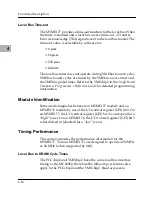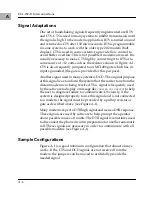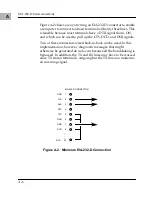
MVME177 Functional Description
4-13
4
❏
TXD
❏
RTS
❏
DTR
It also interfaces to the synchronous clock signal lines. Refer to the
Single Board Computers Programmer's Reference Guide
for drawings of
the serial port interface connections.
All four serial ports use EIA-232-D drivers and receivers located on
the main board, and all the signal lines are routed to the I/O
connector. The configuration headers are located on the main board
and the MVME712
x
transition board. An external I/O transition
board such as the MVME712
x
should be used to convert the I/O
connector pinout to industry-standard connectors.
Note
The MVME177 board hardware ties the DTR signal
from the CD2401 to the pin labeled RTS at connector
P2. Likewise, RTS from the CD2401 is tied to DTR on
P2. Therefore, when programming the CD2401, assert
DTR when you want RTS, and RTS when you want
DTR.
The interface provided by the PCCchip2 allows the 16-bit CD2401
to appear at contiguous addresses; however, accesses to the
CD2401 must be 8 or 16 bits. 32-bit accesses are not permitted. Refer
to the CD2401 data sheet and to the PCCchip2 in the
Single Board
Computers Programmer's Reference Guide
for detailed programming
information.
The CD2401 supports DMA operations to local memory. Because
the CD2401 does not support a retry operation necessary to break
VMEbus lockup conditions, the CD2401 DMA controllers should
not be programmed to access the VMEbus. The hardware does not
restrict the CD2401 to onboard DRAM.
Summary of Contents for MVME177
Page 1: ...MVME177 Single Board Computer Installation and Use Manual VME177A IH2 ...
Page 6: ......
Page 42: ...Hardware Preparation and Installation 2 18 2 ...
Page 52: ...Operating Instructions 3 10 3 ...
Page 80: ...EIA 232 D Interconnections A 8 A ...
















































